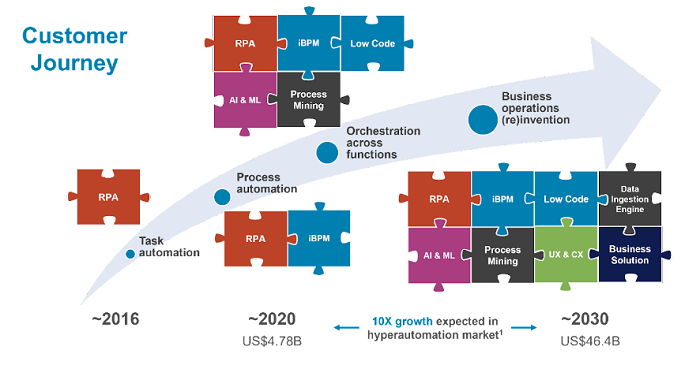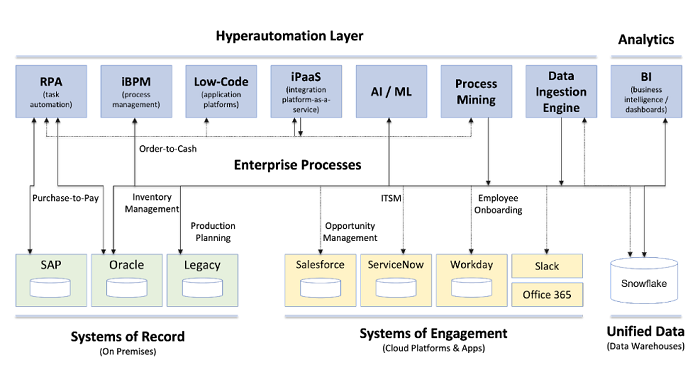
In this special guest feature, Robert Duffner, digital portfolio leader for NTT DATA‘s Enterprise Application Services, outlines what hyperautomation is and how to determine if it is a fit for your organization. Robert Duffner has over 25+ years’ experience in enterprise software having successfully created two startups and held product leadership roles at IBM, Microsoft, Salesforce, ServiceNow, AWS and Docker. As a global technology executive, he blends his background in software product management and modern application development with a depth of experience in enterprise architecture, developer engagement, and design thinking. Robert is passionate about helping clients successfully deliver on their digital transformation initiatives.
Hyperautomation includes using advanced technologies, like artificial intelligence (AI) and machine learning (ML), to automate processes and tasks in order to improve efficiency and productivity across various industries and processes. With the help of AI and ML, hyperautomation can identify patterns and insights that can be used to optimize automation processes and make them more efficient and effective. This article examines the fundamental components of hyperautomation as it applies to businesses and how it fits into a modern IT architecture stack.
The goal of this article is to (1) help the reader better understand hyperautomation and the various components that make up this concept, and (2) allow you to effectively sift through the swath of technologies available and prioritize the most relevant ones for your digital initiatives. Hyperautomation is a customer journey, not a destination, with the goal of making your enterprise more resilient.
It is worth noting that AI and ML are related but distinct concepts. AI is a broader term that encompasses multiple technologies and approaches in the simulation of human intelligence such as recognizing speech or patterns, solving problems, and making decisions. ML is a specific approach to achieving AI. By learning from large data sets, ML focuses on the development of algorithms and statistical models that enable computers to perform tasks without explicit instructions. Most of the components introduced here are ML-based.
What makes automation “hyper?”
Hyperautomation goes beyond traditional automation tools by using a combination of artificial intelligence (AI) and machine learning (ML), to achieve higher levels of efficiency and productivity. Increasingly, it employs low-code/no-code software development tools to make creating the code behind the automation simpler and faster. It also offers expanded capabilities such as process mining with AI and ML, transforming business processes and enabling new ones that would have otherwise been impossible with simple automation capabilities. This combination of technologies and expanded capabilities makes hyperautomation “hyper” or more advanced compared to traditional automation.

Fig.1 illustrates the elements of hyperautomation as “puzzle pieces” in a business-driven technology framework that accelerates digital transformation initiatives. From left to right, you can see how adoption can start from task automation all the way to the re-invention of your business operations. It bears mentioning that the hyperautomation market is estimated to reach US$46.4 billion by 2031 and grow at a CAGR 21.7% between 2021-2031 according to research done by Sheer Analytics and Insights Pvt. Ltd. This is where enterprises are prioritizing their IT spend.
What are the elements of hyperautomation?
Hyperautomation is not a single discreet technology component. It is a concept that encompasses multiple technologies, tools and processes in an integrated and coordinated fashion. It can be any mix of open-source software, commercial software, or custom-developed software developed in-house or by a systems integrator. Hyperautomation typically consists of the following elements:
- Robotic Process Automation (RPA): (RPA) is a technology that enables businesses to use software robots, sometimes known as “bots,” to automate repetitive, manual tasks and procedures, like data entry and processing. RPA gives businesses a rapid, cost-effective solution to automate operations, freeing up staff time for higher-value activities. Commercial examples include UiPath, Automation Anywhere, Blue Prism, and NTT DATA’s Nucleus RPA product.
- Intelligent Business Process Management (iBPM): iBPM is a technology-driven approach to managing business processes utilizing AI and ML to automate and optimize complex business processes. iBPM combines traditional Business Process Management (BPM) techniques with advanced technologies to provide end-to-end process automation, real-time monitoring and optimization, and data-driven decision-making. Commercial examples include: Appian, Pega, IBM BPM, Oracle BPM, and NTT DATA Nucleus BPM.
- Artificial Intelligence (AI) / Machine Learning (ML): As mentioned above, AI/ML is interfused with all the elements of hyperautomation listed here. However, there are several stand-alone tools that are commonly used in hyperautomation. Examples include open-source tools such as ChatGPT, TensorFlow, PyTorch, and Keras. Commercial examples include Microsoft Azure Learning, Amazon Sagemaker, and IBM Watson Studio.
- Process Mining: Process mining is a technique that uses data analysis and process visualization to understand, monitor, and optimize business processes. It involves the extraction of data from various sources, such as process logs, ERP systems, and databases, to create a visual representation of a process. Process mining allows organizations to improve the efficiency and effectiveness of their processes, reduce manual effort, and increase overall competitiveness. Commercial examples include: Celonis, SAP Signavio, Fluxicon Disco, Microsoft Minit, and ABBYY Timeline.
- Low-Code/No-Code Software Development: Low-code software development is a method of creating applications using visual models instead of writing traditional computer code. It provides a graphical user interface (GUI) that enables non-technical users to build and deploy applications quickly and easily, without having to write extensive amounts of code. Low code can be used by professional developers, novice developers, subject matter experts, business stakeholders, and decision makers to build value-driven enterprise business applications. Many SaaS platforms offer low code development such as Microsoft’s Power Platform, ServiceNow, and Salesforce. Other commercial options include Pega, OutSystems, and Mendix.
- Data Ingestion Engine: This component helps automate the process of acquiring and importing data from various sources. Data ingestion is a critical step in the automation process as it enables organizations to extract valuable insights from data and use them to drive business decisions. It does so by collecting, parsing, and integrating data from various sources, such as databases, applications, and cloud services, into a centralized repository for further analysis and processing. Examples include open-source platforms such as Apache Kafka and Apache NiFI while commercial examples include Talend, Informatica, Microsoft Azure Data Factory, Amazon Kinesis, and NTT DATA’s Nucleus Platform.
- User Experience (UX) and Customer Experience (CX): UX and CX play very important roles in hyperautomation by automating manual and repetitive tasks. It can improve the user and customer experience by reducing wait times and errors while improving the overall quality of products and services. By using AI and ML, it can provide personalized and data-driven experiences that improve customer engagement and satisfaction.
- Business Solutions (SaaS platforms): SaaS platforms are cloud-based applications that are delivered over the internet and a critical element to hyperautomation. SaaS platforms provide organizations with a cost-effective and scalable way to access a wide range of software applications and services, without the need for expensive hardware, software, or IT support. More and more vendors are incorporating AI and ML into their software platforms. Examples of some of these SaaS platforms include ServiceNow, Salesforce, Oracle Cloud, SAP’s S/4 HANA, Microsoft Dynamics, and many others.
How hyperautomation fits into a modern IT stack
All the hyperautomation elements come together in a modern enterprise IT stack as a collection of software and hardware technologies as represented in Fig.2. The IT stack is designed where the components work together to support your organization in achieving your digital transformation goals. The specific components and technologies that make up a modern enterprise IT stack will vary depending on the specific needs and requirements of an organization and where you sit from adoption maturity.

Now that you have a baseline understanding of hyperautomation, you can implement it in your organization. This includes assessing your current processes, evaluating your enterprise environment, and developing a roadmap that outlines the steps that your organization can take to implement hyperautomation. It is always best to start small with a tactical project such as implementing RPA, BPM, or process mining to get a quick win and show value.
Sign up for the free insideBIGDATA newsletter.
Join us on Twitter: https://twitter.com/InsideBigData1
Join us on LinkedIn: https://www.linkedin.com/company/insidebigdata/
Join us on Facebook: https://www.facebook.com/insideBIGDATANOW




Speak Your Mind